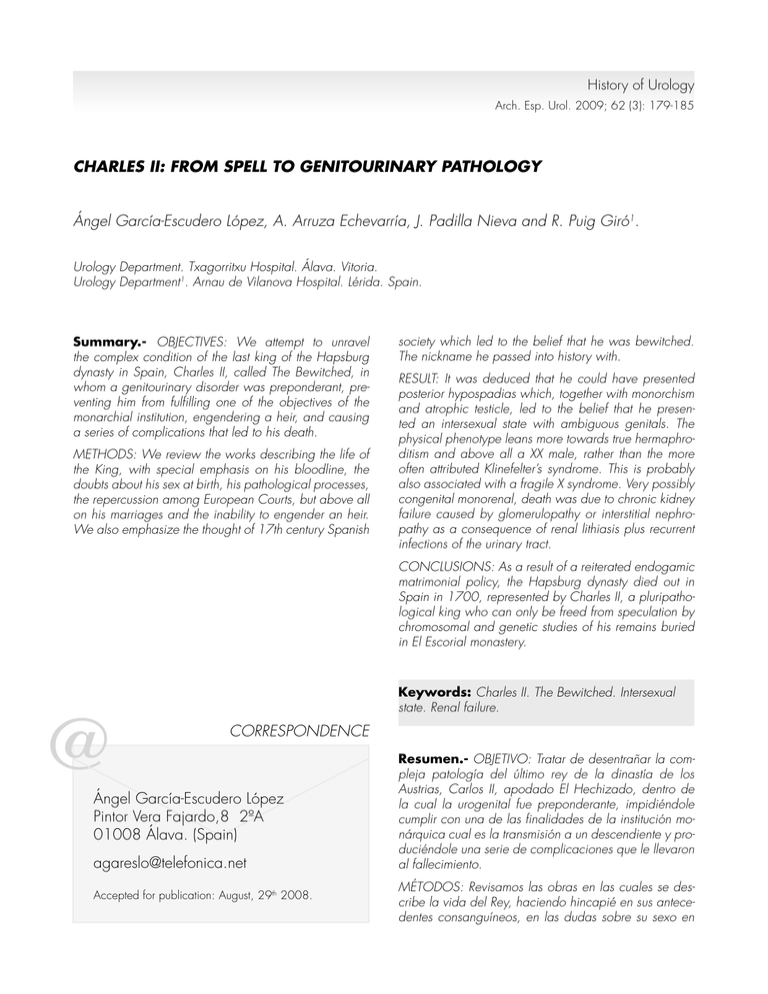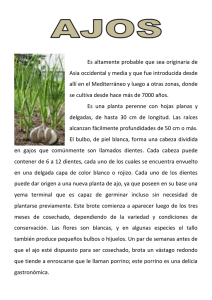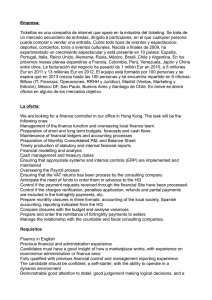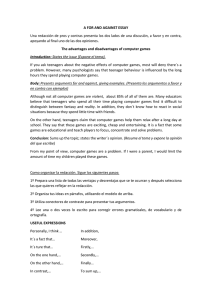CHARLES II: FROM SPELL TO GENITOURINARY
Anuncio

History of Urology Arch. Esp. Urol. 2009; 62 (3): 179-185 CHARLES II: FROM SPELL TO GENITOURINARY PATHOLOGY Ángel García-Escudero López, A. Arruza Echevarría, J. Padilla Nieva and R. Puig Giró1. Urology Department. Txagorritxu Hospital. Álava. Vitoria. Urology Department1. Arnau de Vilanova Hospital. Lérida. Spain. Summary.- OBJECTIVES: We attempt to unravel the complex condition of the last king of the Hapsburg dynasty in Spain, Charles II, called The Bewitched, in whom a genitourinary disorder was preponderant, preventing him from fulfilling one of the objectives of the monarchial institution, engendering a heir, and causing a series of complications that led to his death. METHODS: We review the works describing the life of the King, with special emphasis on his bloodline, the doubts about his sex at birth, his pathological processes, the repercussion among European Courts, but above all on his marriages and the inability to engender an heir. We also emphasize the thought of 17th century Spanish society which led to the belief that he was bewitched. The nickname he passed into history with. RESULT: It was deduced that he could have presented posterior hypospadias which, together with monorchism and atrophic testicle, led to the belief that he presented an intersexual state with ambiguous genitals. The physical phenotype leans more towards true hermaphroditism and above all a XX male, rather than the more often attributed Klinefelter’s syndrome. This is probably also associated with a fragile X syndrome. Very possibly congenital monorenal, death was due to chronic kidney failure caused by glomerulopathy or interstitial nephropathy as a consequence of renal lithiasis plus recurrent infections of the urinary tract. CONCLUSIONS: As a result of a reiterated endogamic matrimonial policy, the Hapsburg dynasty died out in Spain in 1700, represented by Charles II, a pluripathological king who can only be freed from speculation by chromosomal and genetic studies of his remains buried in El Escorial monastery. @ Keywords: Charles II. The Bewitched. Intersexual state. Renal failure. CORRESPONDENCE Ángel García-Escudero López Pintor Vera Fajardo,8 2ºA 01008 Álava. (Spain) [email protected] Accepted for publication: August, 29th 2008. Resumen.- OBJETIVO: Tratar de desentrañar la compleja patología del último rey de la dinastía de los Austrias, Carlos II, apodado El Hechizado, dentro de la cual la urogenital fue preponderante, impidiéndole cumplir con una de las finalidades de la institución monárquica cual es la transmisión a un descendiente y produciéndole una serie de complicaciones que le llevaron al fallecimiento. MÉTODOS: Revisamos las obras en las cuales se describe la vida del Rey, haciendo hincapié en sus antecedentes consanguíneos, en las dudas sobre su sexo en 180 A. García-Escudero López, A. Arruza Echevarría, J. Padilla Nieva et al. el momento del nacimiento, sus procesos patológicos, la repercusión en las Cortes europeas, pero sobre todo en sus matrimonios y en la incapacidad para generar un heredero. Resaltamos como, siguiendo el pensamiento de la sociedad española del siglo XVII, hizo pensar que se encontraba hechizado. Sobrenombre con el que pasó a la historia. RESULTADO: Deducimos que pudo presentar un hipospadias posterior que junto con la monorquia y testículo atrófico, hace pensar que presentó un estado intersexual con genitales ambiguos. Su fenotipo físico inclina más hacia un hermafroditismo verdadero y sobre todo un varón XX, que hacia un síndrome de Klinefelter que ha sido el más atribuido. Es probable su asociación con un síndrome X frágil. Monorreno congénito muy posiblemente, su muerte se debió a una insuficiencia renal crónica producida por una glomerulopatía o una nefropatía intersticial a consecuencia de una litiasis renal más infecciones del tracto urinario recidivantes. CONCLUSIONES: Fruto de una reiterada política matrimonial endogámica, feneció en 1700 la dinastía de los Habsburgo en España encarnada en Carlos II, un monarca pluripatológico que solo se libraría de especulaciones si se efectuaran estudios cromosómicos y genéticos de sus restos presentes en el monasterio de El Escorial. Palabras clave: Carlos II. El Hechizado. Estado intersexual. Insuficiencia renal. INTRODUCTION History of a bewitchment King Charles II, known as the Bewitched King, died on 1 November 1700. He was the successor of a dynasty that reigned in Spain since the early 16th century and the result of a family which, having practiced an endogamic matrimonial policy, had degenerated and deteriorated generation after generation. He left a human, social and economically ruined Castile, the consequence of sometimes aggressive, and often unnecessary, interventionism in European affairs. Even though this Castile was that of Cervantes, Lope de Vega, Quevedo, Velázquez, Zurbarán and many others. The barbarous inbreeding described by Marañón, led Philip II to marry his niece, Philip III to marry a cousin and Philip IV another niece. There was a crossed bloodline with French princesses, as part of peace treaties, but Isabel de Valois had no male offspring with Philip II, and Isabel de Borbon bore prince Baltasar Carlos to Philip IV. The prince died in 1646 with marriage already contracted to his cousin, Mariana of Austria, thus obliging the king to take his place (Figure 1). Charles II was born on 6 November 1661, five days after the death of his brother Philip Prospero, the joy was immense with the news of the birth of the prince and heir being published in La Gaceta of Madrid and describing him as “a robust male, handsome of face, well proportioned head, black hair and somewhat pudgy”. The courts of Paris and Vienna were almost as interested in the-new born prince as his parents. A letter sent from Vienna to the Count of Potting, the imperial ambassador in Madrid, stated textually “They say quite clearly, among other things, that they do not think Spain has a prince, because he is not male but female”. Also concerned, Louis XIV sent Jacques Sanguin to present his congratulations to the royal family and resolve all doubts about the sex of new-born child. Philip IV, aware of the news spreading around Europe, allowed him to see the baby (dressed), and the following report was sent to Louis XIV: “The prince seems extremely weak, both cheeks have a herpes-type rash, the head is covered with scabs, and below the right ear a type of suppurating duct or drainage has formed. We have heard of this through other channels as the bonnet the child usually wears prevents seeing this area”. His childhood was extremely complicated, at three years of age the bones of the cranium had still not closed and the child could not stand, he could not walk until six years of age and even at nine still did so with difficulty. Until four years of age his diet was exclusively breast milk, and he was fed by fourteen wet nurses who in the end had to be changed continually because of the bites given to their nipples. As he was declared king at this age and it was rather indecorous, his mother ordered breastfeeding to be suspended. He had bronchial and dental infections, measles and chicken pox at six years of age, rubella at ten and smallpox at eleven and frequent bouts of diarrhoea as a result of the family prognathism that led to poor eating habits, his gluttony and the medical prescriptions of that time. He was addicted to chocolate. He suffered epileptic seizures which became more severe towards the end of his life. The physical and bodily weakness was further complicated by a lack of intellectual development, at nine years of age he spoke with difficulty and could not read or write. In spite of having the best teachers available, demands were minimum. Lacking in willpower, which was heightened by the authoritarianism CHARLES II: FROM SPELL TO GENITOURINARY PATHOLOGY of his mother, he was always at the mercy of his family, although his excesses of wrath were frequent. The testament of Philip IV established a regency for his widow until the child King came of age, at that time established as fourteen. The situation was so extreme, that as early as 1668 Louis XIV (cousin and brother-in-law of Charles II) and emperor Leopold (brother-in-law and of the same Hapsburg family, with multiple ancestors in common), agreed on the distribution, in the event of death, of The Netherlands, Navarre, Franche-Comté, Naples, Sicily and the Philippines for the former and the kingdoms of Castile and Aragon, the Indies and the territories to the north of Italy, for the latter. However neither of the two renounced, as would occur later, taking over the whole area. In 1669, one of the frequent attacks of fever he presented was accompanied by haematuria, a situation which would be repeated on various occasions. 181 Once the King came of age, consideration was given to his marriage. Although at first consideration was given to an Austrian princess (more kinship) promoted by the queen mother, when she fell out of favour the court leaned more and more in favour of a French princess. It was decided to select a niece of Louis XIV, Maria Luisa of Orleans (2nd niece of Charles II). It was necessary to wait for the Nimega peace treaty in 1678 (when the Franche-Comté was finally lost), to discuss this subject in the French court. Through the mediation of Queen Maria Teresa, sister of Charles II and wife of Louis XIV, this was accepted but without agreeing to the return of any territory to Spain. The anguish of the future bride was tremendous, and only worsened when the French ambassador, Marques of Villars wrote to the court: “The Catholic King is so ugly as to cause fear and he looks ill”. In 1679 when the King was 18 years old, the wedding was celebrated in Quintanapalla, where the King had travelled, keen to meet his future bride. FIGURE 1. Family tree. Extracted from the Encyclopaedia Britannica. 182 A. García-Escudero López, A. Arruza Echevarría, J. Padilla Nieva et al. Maria Luisa of Orleans was not loved by the people because she was French, but above all for not giving the King an heir. This was the greatest concern of the court and it was suspected that the Marquise of Soisson, famous poisoner of the court of Louis XIV, had used witchcraft to take away his ability to produce children. Under the auspices of the queen mother, an astrologist from Bohemia pointed out that the cause of the sterility of the couple was because he had not taken farewell of his father on his death bed and so Charles II went to El Escorial monastery, ordered the mummy of Philip IV to be disinterred so he could be with it for a period of time. On one occasion the queen confessed to a lady-in-waiting that the king suffered premature ejaculation and this prevented him from consummating the marriage. When the French ambassador heard this he bribed a palace laundry woman to give him the king’s underwear and the queen’s bed linen as at that time the Royal Society of London knew of the existence of spermatozoa. They resorted to all the formulas, both divine and mundane to achieve the desired pregnancy. This caused the queen frequent intestinal problems and during the last few years of her life she feared that she was being poisoned. She died in 1689 from appendicitis with peritonitis, treated by applications to the abdomen of “slices of bread soaked in Lucena wine”. The king was distraught. that the cause was the widow queen Mariana so that she could stay in power”. The exorcist proposed a remedy consisting of his majesty taking a “half a litre of oil while fasting with the blessing of exorcisms”. Ten days later, the members of the Privy Council suggested a new marriage for the king and wife they chose was Marie-Anne of Neubourg, whose greatest merit was that her parents, the Electors of Saxony, had borne 23 children. Throughout the history of Medicine, numerous authors have attempted to untangle the complex pathology that affected King Charles II, mainly conditioned by the barbarous inbreeding described by Marañón. For this author, he suffered panhypopituitarism and progeria and he also mentioned that he presented infantile rickets, probably brought about by a lack of Vitamin D as he was not taken out into the open air and even less into sunlight for fear of catching a cold. Gargantilla and Castillo coincide with this diagnosis and add that his sterility was probably due to Klinefelter syndrome (2, 3). Rey Bueno referred to studies by other authors and concluded that he was affected by a terrible epidemic of malaria that occurred in Madrid during 1693, a process that became chronic and whose complications caused his death4. Navalón and Ferrando, based on his mental disability and physical phenotype, speculated that he could have presented a fragile X syndrome (5) (Figure 2). Over the last few years of his life the physical problems became worse and led to advanced ageing. But in the court the greatest concern was the lack of heirs for the king, neither had queen MarieAnne, from such a prolific family. been the solution. In view of the lack of a medical explanation, the situation was attributed to the monarch being the object of witchcraft. The king was so deeply affected by this bewitchment that in 1698 and through his confessor, Father Froilán Diaz, the General Inquisitor was asked to begin a process of disenchantment. The confessor knew that there was a convent in Caldas de Tineo (Asturias) that housed several possessed nuns and that Father Fray Antonio Alvarez Argüelles had exorcist powers. They sought him out and in front of the Sacred Sacrament asked the devil whether the king was bewitched, the answer was yes. Satan added “that the spell had been cast in a cup of chocolate on 3 April 1675 and containing the dissolved brain of an executed criminal to take away his reason, intestines to take away his health and kidneys to corrupt his semen and prevent him from engendering offspring and His clinical condition, aggravated by the potions he was being given, became worse. In March 1698 the French ambassador, Marques d´Harcourt, wrote to Louis XIV: “he is so weak that he can not be out of bed for more than one or two hours”, “he must always be aided when getting into or out of his carriage”, “he has swollen feet, legs, abdomen, face and sometimes even his tongue so that he can not speak”. Oedemas, fatigue, attacks of epilepsy, incurable diarrhoea, attacks of fever ….until on 1 November 1700, at almost 39 years of age, he died. Kings were not subject to post-mortem examinations but because Charles II was considered to be bewitched, an autopsy was performed resulting in “a very small heart of the size of a grain of pepper, the lungs corroded, the intestines putrefactive and gangrenous, in the kidney three large stones, a single testicle as black as coal and his head full of water” (1). Clinical profile Klinefelter’s syndrome, described in 1942 (6), is the most frequently observed sexual chromosome disorder, the majority being revealed in adolescence as a result of gynecomastia, small atrophic testicles and short penis, although sometimes directly because of sterility. Patients are tall at the expense of the lower part of the body, lack axillary and facial hair and have slight mental disability and poor so- CHARLES II: FROM SPELL TO GENITOURINARY PATHOLOGY cial adaptation. The most common karyotype is 47XXY, although there may be mosaicisms such as 46XY/47-XXY which present a much slighter phenotype. There is azoospermia, but when there are 46-XY cell lines there may be spermatogenesis, with even some pregnancy being described. The people in favour of Charles II presenting mosaicism refer to the absence of tallness and gynecomastia. But it is evident that he presented a series of phenotype traits and disorders that seem to indicate this disease (Figure 3). The fragile X syndrome or Martin and Bell syndrome was described in 1943 (7) and is the most common cause of hereditary mental retardation. Its effects are more severe in males (women can compensate for it with the other X chromosome pair) (8). The physical phenotype includes a long face, prominent chin and ears and macrocephalia. It is evident that these physical traits coincide with the portraits by Claudio Coello (Figure 2) and Carreño de Miranda (Figure 3). There is joint slackness and hyperextensibility, flat feet and muscular hypotonia, which produces and coincides with difficulties in walking. Young boys present mental retardation and autism in 30% of cases. Girls present shyness, social anxiety, learning FIGURE 2. 183 difficulties, attention problems, wishful and compulsive behaviour, all to a variable degree. It is evident that the study of the behaviour of Charles II does not indicate very accentuated mental retardation, but there are attitudes that coincide with the secondary aspects. Apart from other neuroanatomical alterations, there was enlargement of the lateral ventricles which could explain finding “the head full of water” as stated in the autopsy. We have already mentioned earlier that there was a certain uneasiness in the French and Austrian courts regarding the succession to the throne of the Spanish monarchy. When Charles II was born, Philip IV was already 56 years old, extremely aged for the period, prince Philip Prospero had died, and both were concerned about the Spanish succession. For this reason they established their connections in the old palace in Madrid and the Austrian court released the news that “they say clearly, among other things, that they do not think Spain has a prince, because the child is not male, but female”. This leads us to believe that the new-born child had ambiguous genitals and therefore an intersexual state. It is well known that the chromosome sex is established at fertilisation, and after that the undifferentiated gonads develop into testicles or ovaries. The phenotype sex is the result of the differentiation of internal ducts and external genitals under the influence of hormones and transcription factors (9). Any disagreement between these processes produces ambiguous genitals or intersexuality. There are two pieces of information mentioned earlier that are important to recall at this time. The autopsy only found one testicle and atrophic at that. This could be unilateral testicular agenesis (monorchism), accompanied by contralateral cryptorchidism which in itself would have conditioned secondary atrophy or there could have been a twist in the spermatic cord during childhood. And we also recall the confession of Queen Maria Luisa of Orleans that the king suffered premature ejaculation that prevented him from consummating the marriage and which led the French ambassador to examine their underwear. With this expression the queen wanted to say that the poor ejaculate of the king did not enter her vaginal cavity and would corroborate the presence of penoscrotal, scrotal or perineal hypospadias which was not mentioned in the autopsy. Among intersexual states there are also feminine and masculine pseudohermaphroditism due to a deficiency in the five genes and coding enzymes required for the biosynthesis of steroids from cholesterol to testosterone, and which are incompatible with life without hormone replacement therapy. The androgen insensitivity syndrome would have given him a female 184 A. García-Escudero López, A. Arruza Echevarría, J. Padilla Nieva et al. sex and 5-alpha-reductase deficiency is nonexistent in Europe (10). Most probably this was a case of true hermaphroditism which requires expression of ovarian and testicular tissue and is the result of mosaicism or chimerism of the sexual chromosome or translocation of the Y chromosome (11). The most common karyotype in Europe is 46-XX/46-XY or 47-XXY mosaicism. The king could have had an intra-abdominal ovary or ovotestis that was not investigated in the autopsy, together with a contralateral cryptorchidic testicle. This would be accompanied by hypospadias and incomplete fusion of the labioscrotal folds. It could also be sexual inversion, with male phenotype, XX karyotype and be due to anomalous translocation of Y to X involving the SRY gene during meiosis. XX males are usually of smaller size than normal and often associated with ambiguous genitals, hypospadias and cryptorchidic testicles (12). If this is not so they usually attend the clinic for sterility consecutive to azoospermia, and an examination reveals testicular atrophy (13). Should this be associated with a fragile X syndrome, this would then explain why the mental retardation of the king was not very serious. His general medical record is no less complex. A series of clinical data allow us to reflect on the diseases that the king could have presented. He already suffered multiple attacks of fever even in childhood, on several occasions accompanied by haematuria the first at eight years of age. Over the last few years of his life, the attacks of fever were attributed to the malaria he suffered in 1693, and which was treated with quinine as well as the classic remedies of the period including, surprisingly enough, eating powdered vipers and chickens fed on them. This could be the cause of the numerous gastrointestinal problems he suffered throughout his life. Two years before his death, what most attracted the attention of the French ambassador were the generalised oedemas that affected the king. Finally in the autopsy, they mention a small heart and three large kidney stones. If we consider that in 33% of cases, there is an association between testicular and renal agenesis due to an anomaly of Wolf’s duct (14) and the autopsy mentions “the” kidney with three large stones, we can conclude he was congenital monorenal. The generalised oedemas together with finding an non-hypertrophic heart in the autopsy, leads us to believe that he presented a nephrotic syndrome that resulted in chronic kidney failure and death. The fact that he presented haematuria on various occasions as a result of attacks of fever, seems to indicate post-streptococcal glomerulonephritis that developed into chronic glomerulonephritis, cause of the nephrotic syndrome and the impaired renal function. Nevertheless, it cannot be excluded that the episodes of fever and haematuria were the result of infections of the urinary tract, as corroborated by the presence of three large kidney stones. Apart from a congenital obstructive uropathy, the aetiopathogenesis of the renal lithiasis could be attributed to hyperuricosuria (given the family history of the Hapsburg), hyperoxaluria and hypocitraturia as a result of the reiterated intestinal inflammatory processes he suffered, or be of infectious origin. Therefore, the chronic kidney failure could also be considered a result of the renal lithiasis together with reiterated urinary tract infections. And this could be further complicated by membranous glomerulonephritis as a result of the malaria, leading to a nephrotic syndrome and worsening the impaired renal function that caused the death of the monarch. CONCLUSIONS FIGURE 3. After analysing the record of the last monarch of the Hapsburg line, Charles II, we conclude that CHARLES II: FROM SPELL TO GENITOURINARY PATHOLOGY the bewitchment those close to him claimed he suffered, accepted by him and which prevented him from producing an heir, was due to an intersexual state, most probably true or male XX hermaphroditism, possibly associated with a fragile X syndrome. All this the result of the continued inbreeding of the Hapsburg family. His death was due to chronic kidney failure, either as a result of glomerulopathy or tubule-interstitial nephropathy secondary to renal lithiasis and infection very probably in a congenital monorenal patient. REFERENCES AND RECOMENDED READINGS (*of special interest, **of outstanding interest) **1. Calvo Poyato J. La vida y la época de Carlos II el Hechizado. Ed. Planeta. Barcelona 1996. **2. Gargantilla Madera P. Enfermedades de los reyes de España, los Austrias : de la locura de Juana a la impotencia de Carlos II el Hechizado. Ed. La esfera de los libros. Madrid 2005. *3. Castillo A. Carlos II : El fin de una dinastía enferma. www. arturosoria. com. 2005. *4. Rey Bueno M. Tradición y modernidad. La asistencia farmaceútica en la corte española de los siglos XVI Y XVII. Tesis Doctoral. Facultad de Farmacia. Madrid 1999. *5. Navalón Ramón E, Ferrando Lucas MT. La enfermedad de Carlos II. Revista Valenciana de Medicina de Familia 2006; 22: 16-19. 185 6. Klinefelter HF, Reifenstein EC, Albright F. Symdrome characterized by gynecomastia, aspermatogenesis without A-leydigism and increased excretion of follicle-stimulating hormone. J Clin Endocrinol. 1942; 2 : 615-627. 7. Martin JP, Bell J. A pedigree of mental defect showing sex linkage. J Neurol Psychiatry. 1943; 6: 154-157. 8. Hagerman RJ. “Fragile X síndrome”. En Neurodevelopmental disorders : Diagnosis and Treatment. Oxford University Press. New York 1999. *9. Hyun G, Kolon TF. Un enfoque práctico de los estados intersexuales en el periodo prenatal. En Clínicas Urológicas de Norteamérica. Nueva York 2004. *10. Garat JM, Ruiz de Temillo M, de la Peña Zarzuelo E. Alteraciones de la diferenciación sexual. En Tratado de Urología Ed. Jiménez Cruz JF y Rioja Sanz LA.: 723-762. Madrid 2006. 11. Kolon TF, Lamb DJ. Bases moleculares de los transtornos intersexuales. AUA update series 2000; Lección 34, ed. española: 39-50. *12. Espinosa TM, García J, Pérez C, Fernández T, Carvajal F, Tuero A. Transtornos de la diferenciación sexual: 20 años de experiencia. Rev Int Androl. 2007; 5: 218-225. *13. Ballescá JL, Margarit E, Oliva R, Martínez de Osaba MJ, Balasch J. Varones XX: clínica y frecuencia en la consulta de esterilidad. Rev Int Androl. 2007; 5 : 349-353. 14. Mercer S. Agenesis or atrophy of the testis and vas deferens. Canadian J Surg. 1979; 22: 245-246.











